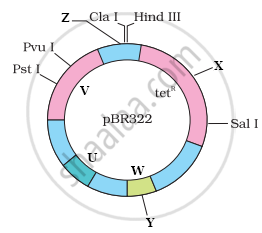Advertisements
Advertisements
प्रश्न
Cloning of genes, play a very significant role in genetic engineering, helping the transfer of desirable foreign genes into different hosts. The scientists, to make this process easier and effective are creating engineered vectors in such a way that they help easy linking of foreign DNA and selection of recombinants from non-recombinants. 'pBR322' is one such engineered vectors developed by scientists. A diagram of an engineered vector pBR322 is given below:

- Name the host for this cloning vector.
- Identify 'Rop' and 'Ori' in the diagram from 'U', 'V', 'W', 'X', 'Y' and 'Z'. Write their functions.
- Draw the fragments that will be formed by the action of 'Z' (marked in the diagram) on the specific site of the DNA segment given below:
5' --- GTACGAATCCTGA --- 3'
3' --- CATGCTTAGGACT --- 3'
उत्तर
- The host for this cloning vector is E.coli.
- Rop is W and Ori is U.
Function of Rop = to provide coding for plasmid replication-related proteins.
Function of Ori = Any DNA fragment can cause the host cells to reproduce any other DNA fragment when linked to this sequence, which is where replication begins. - Z is EcoRI. The recognition sequence's 5' terminus contains a cut between G and A bases. -GAATTC-3' in 5'. Therefore, the fragments produced if the given sequence is treated with EcoRI are:
5' --- GTACG AATTCCTGA --- 3'
3' --- CATGCTTAA GGACT --- 5'
APPEARS IN
संबंधित प्रश्न
Explain the work carried out by Cohen and Boyer that contributed immensely in biotechnology.
Distinguish between RNA and DNA
Describe two vectors less methods of gene transfer used in rDNA technology.
What is the cell that receives a recombinant gene called?
Give a reason why :
Proteases are added during the isolation of DNA for genetic engineering.
Which of the following is TRUE regarding EcoR I?
A hind of biotechnology involving manipulation of DNA is ______.
Which of the following is the correct recognition sequence of restriction enzyme Eco RI?
What is polymerase chain reaction (PCR)?
Name the source of thermostable DNA polymerase.
